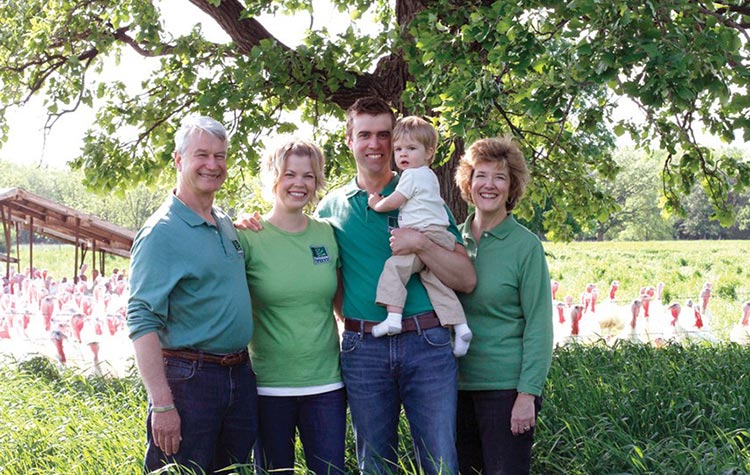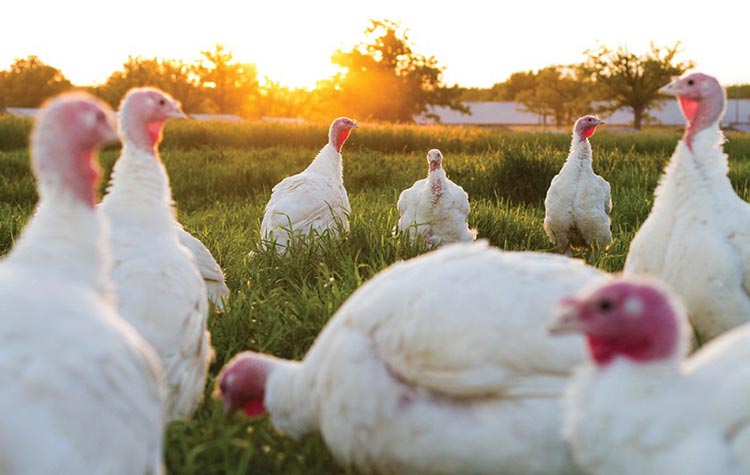From the Blog
Ferndale Free-Range Turkeys

“It’s a perfect autumn day,” John Peterson pronounces, on his farm in the wooded, rolling hills of Cannon Falls, in southern Minnesota. “These are the days that make anyone want to be a farmer! Start the day in flannel, end in a t-shirt.”
John, his wife Erica, and their 2½-year-old Finn, along with his parents Dick and Jane, live and work on the land John’s grandparents purchased for turkey raising in the ‘30s. The key to the farm’s name is hearing that John’s grandparents were Fern and Dale – and, thanks to John and Erica, Ferndale today is much the same as Fern and Dale created it.
The Third Generation
In college, John and Erica had to fend for themselves in the kitchen: “and started to learn about food. It was the early- to mid-2000s, when people were starting to think more about it,” John recalls. Likely, many Co-op shoppers can relate: Michael Pollan’s books, starting with Omnivore’s Dilemma, as well as Barbara Kingsolver’s Animal, Vegetable, Miracle, opened their eyes to what they were seeing in the landscape and on their plates.
While John had worked on the family’s turkey farm as a kid, he hadn’t really thought of it as a career: “The light bulb came on that we should really be a part of this, rather than letting the farm go in a different direction.” Amending our food system requires the current generation to step up and claim it: “We had a pretty unique opportunity to not stand on the sidelines as critics about how food was being produced.” They could help change the game.

Traditional Methods: 75 Years of Raising Free-Range Turkeys
Fern and Dale started their farm in 1939, selecting the land for its perfect turkey raising qualities: sandy soil, in a river valley abutting Little Cannon River, which provides excellent drainage for healthy outdoor animal-raising conditions: “I gain more appreciation for it every year,” John gives a nod to his grandparents. “My grandfather was a bit of a visionary for his time, a pioneer in wanting to grow turkeys for a living. Before that, everyone would just grow a few backyard turkeys for themselves.”
While the farm was initially on-trend by specializing (amid the great transition in agriculture from self-sufficiency family farming to specialization and commodity farming), they bucked the trend when animal-raising turned to confinements: “We were the holdouts after everyone else had quit raising them outside.”
Free-range, naturally: “This is the only way my grandfather would have known how to raise turkeys – and everyone used to,” John notes. The old fashioned methods have come back into vogue in the post-Omnivore’s Dilemma era, when people once again want to know where their food comes from. While Ferndale’s free-range turkeys are “perceived as being niche or specialty market,” John points out, “it makes me chuckle because, really, we’ve changed very little.”
Two Words: Rotational Grazing
It’s music to a conscientious omnivore’s ears: “We keep [the turkeys] rotating onto fresh pasture. It’s a true free-range program, outdoors from early spring.” Managing their two fifteen- and twenty-acre turkey ranges is labor intensive, but “We take pride in managing the land well, and we never have to use pesticides or herbicides. When you do it right, it’s a closed-loop, with the turkeys fertilizing the grass,” – not to mention eating the bugs (all of which makes the turkey taste good).
Also unlike conventional turkeys, Ferndale has a no antibiotics nor growth promotants policy: “There’s the most pride for us in not using treatment antibiotics, as it’s a testament that we’re doing it right.”
The Turkey Tip to Rule them All (from the turkey farmer):
You’ll have a tasty turkey with any cooking method if you buy a good turkey and don’t overcook it. THE RULE: It’s done when it hits 165°F (taken with a meat thermometer). Let it rest 15 minutes for the juices to stabilize, and you should have a good bird.
The Power of the Purse
“By philosophy or idealology, everyone would say they believe in this,” – this being raising animals humanely and compassionately, “but it doesn’t always line up with their pocketbooks,” John notes. “Shoppers need to realize what a big role they have – they’re the ones that make the change!” Every business responds to a consumer need, he points out: “If everyone stopped buying conventional meat, it’d be over tomorrow.”
John's Winter Reads
The Meat Racket by Christopher Leonard – a history of Tyson Foods’s current domination of our meat industry
In Meat We Trust by Maureen Ogle – a history of American meat production
Beyond ethics and animal treatment, “I do indeed think there’s a flavor difference,” between conventionally-raised and Ferndale-raised turkeys. “Certainly our birds get more muscle movement,” which adds “richness to the flavor and texture. Chefs tell us they can tell a difference just by looking at the raw meat – it’s a richer, darker color.” Just like in vegetables, more color usually indicates greater nutrient density and flavor.
Ferndale turns to tradition with the meat’s processing as well: “A real flavor difference is that we don’t add anything to it. [Standard turkeys] always have added water, sodium, ‘basting solution’… not only does it take away from the flavor, but it tricks the customer into buying water weight.” Wholesome ingredients shouldn’t be augmented: “If we raise a tasty turkey, there’s no reason to add anything – it should just be 100% turkey.”
Gathering around your holiday table, we hope you give thanks to the bird and the farmer too: “We consider it an honor that the turkeys we raise are the centerpieces of one of the most memorable meals of the year,” John notes. It turns out – particularly for a holiday table – traditional methods just taste better.
Ferndale’s Grilled Turkey Recipe
There are dozens of good ways to cook a turkey, but the folks at Ferndale grill their holiday turkey every year for 2 reasons:
1. It’s extremely easy: Put it on and walk away.
2. Cooking it on the grill frees up oven space for everything else.
No need to do anything to the bird except salt & pepper it and maybe put a little butter under the skin.
Cook on the grill over indirect heat for about 15min./lb., or until the internal temperature – taken with a meat thermometer – is 165°F.
Let rest 15 min. off heat to stabilize the juices. Carve!
